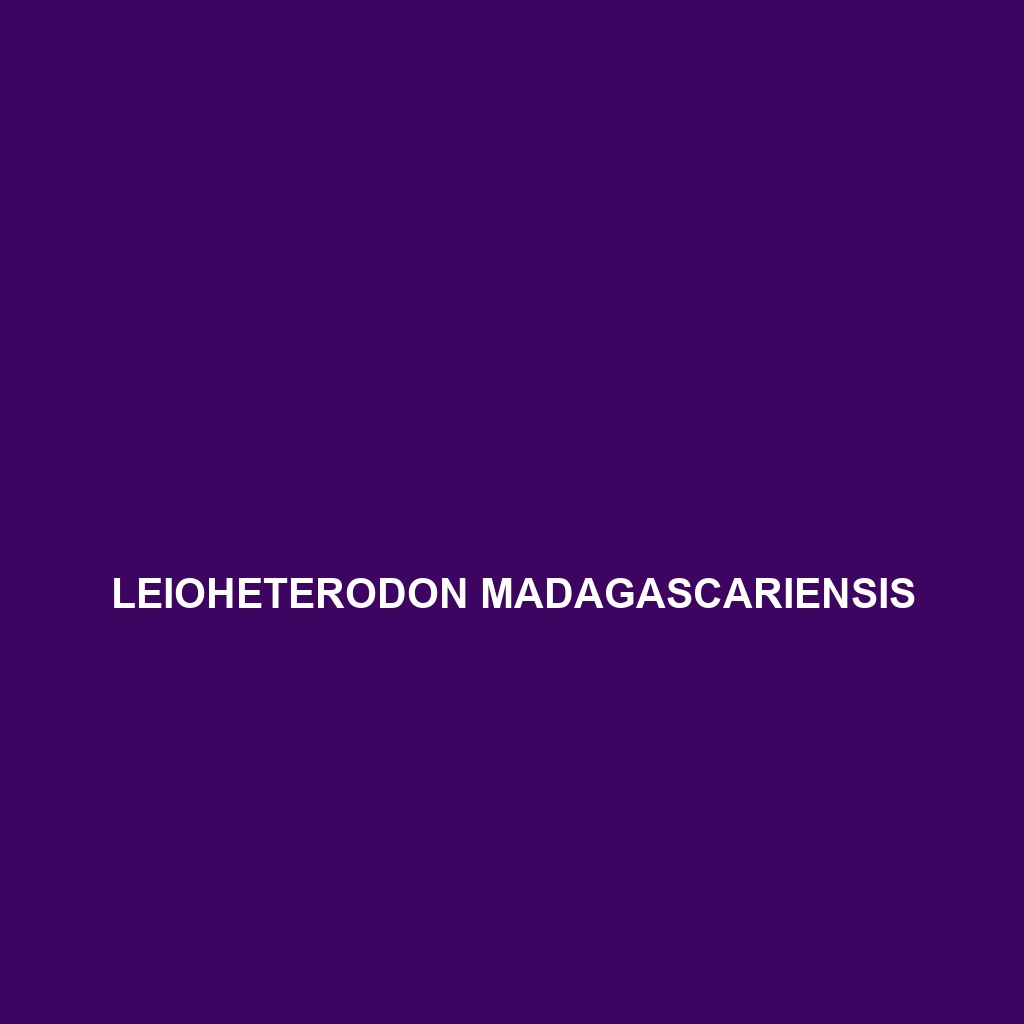Common Name
Leioheterodon madagascariensis
Scientific Name
Leioheterodon madagascariensis
Habitat
Leioheterodon madagascariensis, commonly known as the Madagascar giant hognose snake, is primarily found in the lush rainforests and open savanahas of Madagascar. This species predominantly inhabits humid environments that provide ample cover and food sources. The geographic regions are characterized by a tropical climate, with warm temperatures and significant rainfall, essential for sustaining its preferred habitats. Forests and temperate forests offer necessary shelter and camouflage, while nearby wetlands serve as vital ecosystems that support diverse prey.
Physical Characteristics
Leioheterodon madagascariensis exhibits several distinctive physical features that set it apart from other species. Typically growing between 1.5 to 2 meters in length, this snake possesses a robust body that tapers towards the tail. Its coloration ranges from deep browns to yellowish stripes, providing excellent camouflage among the leaf litter and foliage of its habitat. The head is somewhat flattened, and its unique, often upturned snout makes it easily recognizable. Additionally, it has small, keeled scales that contribute to its textured appearance and tactile sensation. Visually, the species’ size and patterning play a crucial role in its survival, making it an adept predator in its environment.
Behavior
The behavior of Leioheterodon madagascariensis displays both fascinating and notable traits. Primarily nocturnal, the Madagascar giant hognose snake is most active during the evenings and nights, which aids in hunting and escaping predators. During the day, it often hides beneath leaf debris, rocks, or logs, showcasing its excellent camouflage capabilities. Social interactions are relatively limited, with individuals typically leading solitary lifestyles outside of the mating season. The mating rituals occur in late spring; males engage in competitive displays to win over females, showcasing interesting behaviors such as entwining and moving in patterns, highlighting dominance and fitness.
Diet
As a carnivore, Leioheterodon madagascariensis primarily feeds on a diet composed of small mammals, birds, and occasionally amphibians and insects. Its unique morphology allows it to use constriction as a hunting method—a behavior observable in several snake species. During meals, this snake shows a remarkable ability to discern various prey types, often adjusting its hunting strategy based on availability and size. Observations suggest it employs a sit-and-wait tactic, allowing it to remain hidden until prey comes within striking distance.
Reproduction
Reproduction in Leioheterodon madagascariensis typically occurs in the warmer months, potentially between November and January, aligning with the region’s environmental conditions conducive to offspring survival. After mating, females undergo a gestation period lasting approximately three months before laying clutches of 15 to 30 eggs. The eggs are laid in secure locations, often buried within leaf litter to ensure protection from predators and temperature regulation. Once hatched, juveniles are independent and must fend for themselves, quickly adapting to their environment and learning hunting skills essential for survival.
Conservation Status
The conservation status of Leioheterodon madagascariensis is currently classified as vulnerable due to habitat destruction, illegal pet trade, and environmental changes resulting from deforestation and agricultural expansion in Madagascar. Conservation efforts are underway to protect this species, focusing on habitat preservation and raising awareness within local communities about the ecological importance of Malagasy reptiles. Additionally, there are ongoing studies to monitor population dynamics and assess the feasibility of captive breeding programs, which aim to bolster wild populations and their natural habitats.
Interesting Facts
One of the most intriguing aspects of Leioheterodon madagascariensis is its unique ability to mimic other snake species when threatened. This mimicry can include posturing to appear more dangerous or adopting behaviors of more venomous snakes to deter potential predators. Another interesting fact is that this species can consume prey significantly larger than its head due to its highly flexible jaws—an adaptation seen in several snake species that enhances feeding capabilities. Additionally, its defensive display often involves flattening its body and rolling onto its back, which can confuse or divert threats, thereby increasing its chances of escape.
Role in Ecosystem
Leioheterodon madagascariensis plays a vital role in its ecosystem as both a predator and prey. As a predator, it helps to control populations of small mammals and insects, contributing to maintaining a balanced food web. Its presence indicates a healthy environment, supporting biodiversity in Madagascar’s unique ecosystems. Conversely, it is also prey for larger animals, including birds of prey and other larger reptiles. This dynamic role emphasizes the importance of preserving its habitat, as the loss of this snake could significantly disrupt local ecological interactions.
This structured content offers an informative overview of Leioheterodon madagascariensis, integrating SEO-friendly terms conducive to enhancing online visibility while providing a comprehensive understanding of the species.
